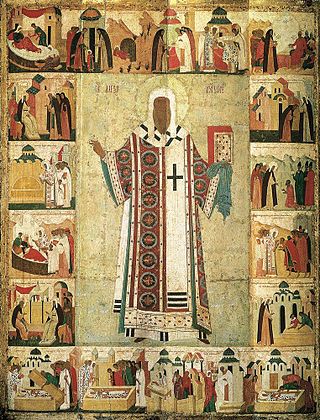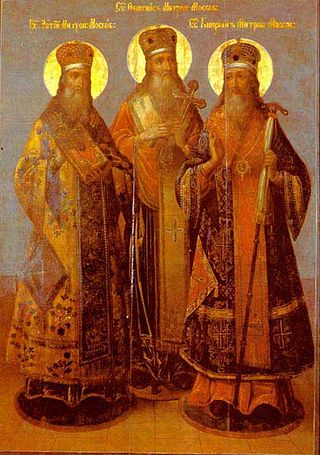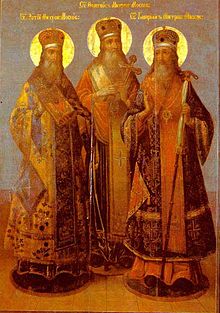
Peter of Moscow was the Russian metropolitan who moved his see from Vladimir to Moscow in 1325. Later he was proclaimed a patron saint of Moscow. In spite of the move, the office remained officially entitled "Metropolitan of Kiev and all Rus'" until the autocephalous election of Jonah of Moscow in 1448.

Alexius was Metropolitan of Kiev and all Rus' and presided over the Moscow government during Dmitrii Donskoi's minority.

Cyprian was a prelate of Bulgarian origin, who served as the Metropolitan of Kiev, Rus' and Lithuania and the Metropolitan of Kiev and All Rus' in the Ecumenical Patriarchate of Constantinople. During both periods, he was opposed by rival hierarchs and by the Grand Prince of Moscow. He was known as a bright opinion writer, editor, translator, and book copyist. He is commemorated by the Russian Orthodox Church on May 27 and September 16.
The Metropolis of Moscow and all Rus' was a metropolis that was unilaterally erected by hierarchs of the Eastern Orthodox Church in the territory of the Principality of Moscow in 1448. The first metropolitan was Jonah of Moscow; he was appointed without the approval of the Ecumenical Patriarch of Constantinople. The metropolis split from the Metropolis of Kiev and all Rus' because the previous metropolitan — Isidore of Kiev — had accepted the Union of Florence. Seventeen prelates succeeded Jonah until Moscow's canonical status was regularised in 1589 with the recognition of Job by the Ecumenical Patriarch. Job was also raised to the status of patriarch and was the first Patriarch of Moscow. The Moscow Patriarchate was a Caesaropapist entity that was under the control of the Russian state. The episcopal seat was the Dormition Cathedral in Moscow.

Metropolitan Photius of Kiev, was the Metropolitan of Kiev and all Rus' in the Patriachate of Constantinople of the Eastern Orthodox Church. He was of Greek descent.

Maximus or Maximos was a metropolitan bishop of the Metropolis of Kiev and all Rus' in the Ecumenical Patriarchate of Constantinople. He was consecrated in Constantinople and reigned from 1283 to 1305. Maximos was of Greek origin.

The history of the Russian Orthodox Church is commonly traced back to the Metropolis of Kiev and all Rus', established upon the Conversion of Volodimer in c. 988 for ecclesiastical administration of Kievan Rus'. Several decades after the end of Kievan Rus' due to the Mongol invasion in 1237–1241, metropolitan Maximos of Kiev and all Rus' relocated to Vladimir on the Klyazma in Suzdalia in 1299, and his successor Peter moved to Moscow in 1325, while still keeping "of Kiev and all Rus'" in their titles.
Gregory the Bulgarian, or Gregory II was Metropolitan of Kiev, Galicia and all Rus'. His title to the metropolitan see was acknowledged both by the Holy See and by the Ecumenical Patriarchate of Constantinople due to their joint acceptance of the Council of Florence which united the Latin and the Eastern Orthodox Churches for a short period of time.
The Metropolis of Lithuania was a metropolis of the Ecumenical Patriarchate of Constantinople in the Eastern Orthodox Church. It was erected on the territory of the Grand Duchy of Lithuania between 1315 and 1317. It was disestablished in 1371. The seat (cathedra) of the metropolis was initially in Navahrudak. It had only two metropolitan bishops. The establishment took place in the aftermath of the Mongol invasion of Kievan Rus' which was exploited by the rulers of Lithuania to greatly expand their territory. To help legitimize their annexations and to bind their new subjects more closely to the state, the royal powers favoured the erection of a metropolis for the inhabitants of the Grand Principality. To avert the possibility of the state going over to the Holy See, the hierarchs based in Moscow latterly supported the erection of the metropolis as the lesser of two evils. Throughout the existence of the metropolis, the metropolitans struggled for religious control of the Rus' eparchies with the secular and religious powers in the Kingdom of Galicia–Volhynia, the Principality of Tver, and the Grand Duchy of Moscow.

The Patriarch of Moscow and all Rus', also known as the Patriarch of Moscow and all Russia, is the title of the primate of the Russian Orthodox Church. It is often preceded by the honorific "His Holiness". As the ordinary of the Diocese of Moscow, the office holder's direct canonical remit extends only to Moscow; however, as Patriarch, the office holder has a number of church-wide administrative powers as laid down by the charter of the Russian Orthodox Church.
Kirill II or Cyril II was the metropolitan of Kiev from 1242 until his death. He was close to the khan of the Golden Horde, Mengu-Timur.
The Metropolis of Halych was a metropolis of the Ecumenical Patriarchate of Constantinople in the Eastern Orthodox Church. It was erected on the territory of the Kingdom of Galicia–Volhynia in 1303 by Patriarch Athanasius I of Constantinople. The episcopal seat of the metropolis was in the city of Halych in the "Cathedral of the Assumption".
The Metropolis of Kiev and all Rus' was a metropolis of the Eastern Orthodox Church that was erected on the territory of Kievan Rus'. It existed between 988 AD and 1440s AD. The long lasting "tug of war" between bishops from the Grand Duchy of Lithuania and Ruthenia and bishops of the Principality of Moscow resulted in reorganization of the metropolis as the bishops from Moscow refused to recognize decisions of the Ecumenical Patriarch of Constantinople. Canonically, it was under the jurisdiction of the Ecumenical Patriarchate of Constantinople. The metropolitan seat (cathedra) was located in the city of Kiev until it was moved to Vladimir-na-Klyazme in 1299 and then Moscow in 1325.
The schism between the Ecumenical Patriarchate and part ofitsMetropolis of Kiev and all Rus occurred between approximately 1467 and 1560. This schism de facto ended supposedly around 1560.

The Metropolis of Kyiv was an autonomous metropolis of the Ecumenical Patriarchate of Constantinople with center in Kyiv after its formation in 988 as a result of the Christianization of Rus by Volodymyr the Great until January 6, 2019, when it received the Tomos on Autocephaly.
The Metropolis of Kiev is a metropolis of the Eastern Orthodox Church that was transferred to the Patriarchate of Moscow in 1685. From 988 AD until 1596 AD, the mother church of the Metropolis of Kiev, Galicia and all Rus' had been the Ecumenical Patriarchate of Constantinople. The Moscow Patriarchate was a Caesaropapist entity that was under the control of the Russian state. While nominally ruled by a metropolitan bishop, since its inception, the secular authorities of the Tsardom of Russia altered the territorial remit of the Kyiv metropolis, stripped it of its suffragan sees and transformed the office from an ecclesiastical province to an archbishopric to an honorific or empty title.








